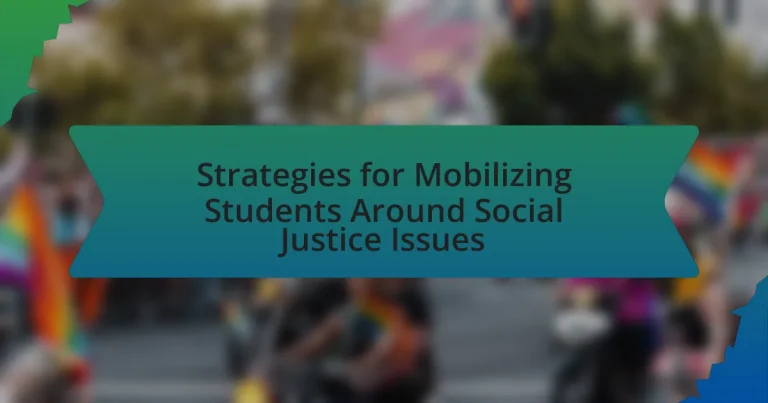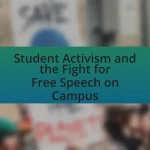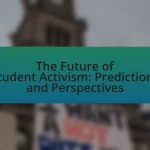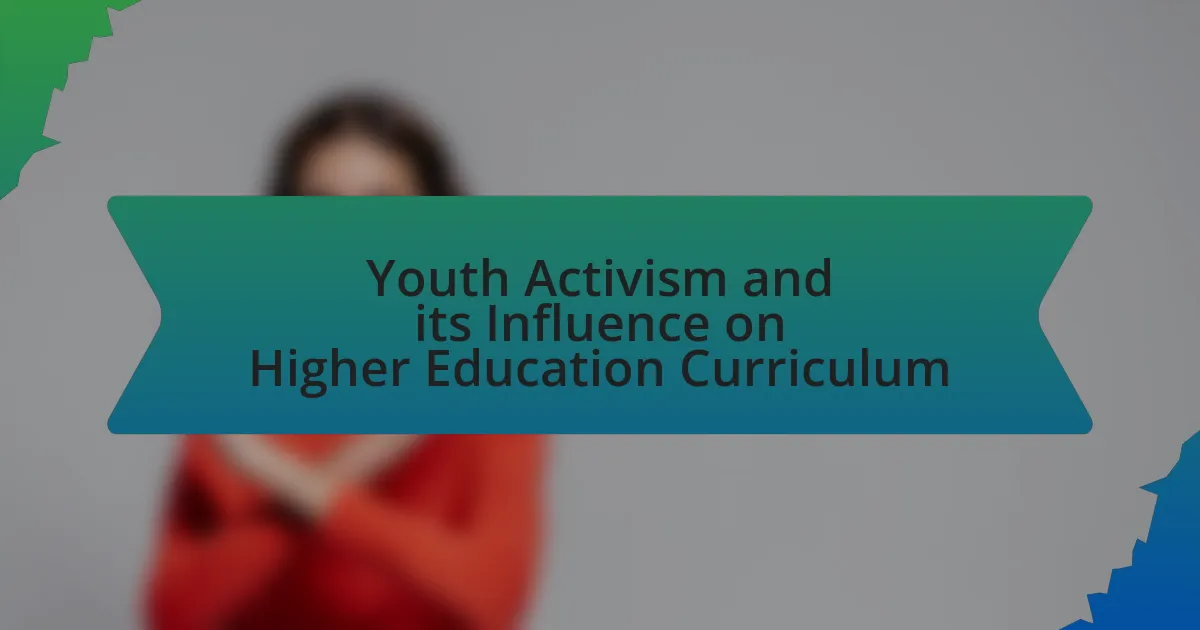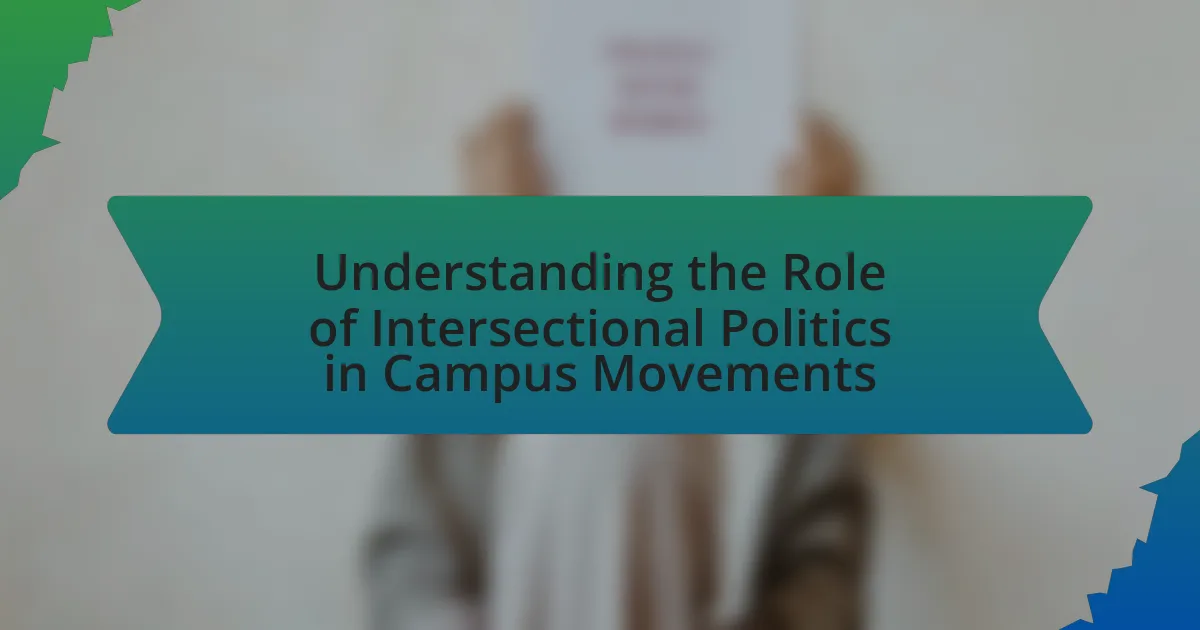The article focuses on strategies for mobilizing students around social justice issues, emphasizing the importance of education, inclusive dialogue, and social media outreach. Key strategies include raising awareness through targeted educational programs, fostering collaborative environments, and utilizing social media for effective communication and engagement. The article also addresses challenges students face, such as resource limitations and apathy, while highlighting the significance of intersectionality and community partnerships in enhancing mobilization efforts. Additionally, it discusses methods for evaluating the effectiveness of these strategies and the importance of continuous improvement in mobilization initiatives.
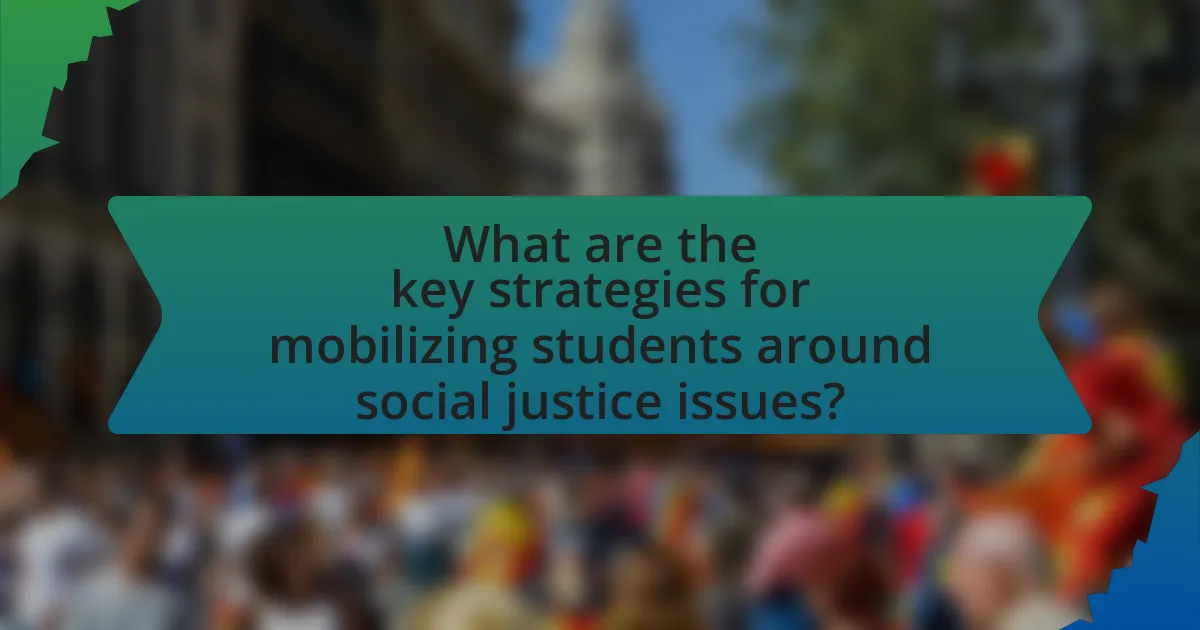
What are the key strategies for mobilizing students around social justice issues?
Key strategies for mobilizing students around social justice issues include fostering awareness through education, creating inclusive spaces for dialogue, and leveraging social media for outreach. Education initiatives, such as workshops and seminars, equip students with knowledge about social justice topics, enhancing their understanding and engagement. Inclusive spaces encourage diverse perspectives, allowing students to share experiences and collaborate on solutions. Social media platforms serve as powerful tools for organizing events, sharing information, and building community support, as evidenced by movements like #BlackLivesMatter, which effectively mobilized youth engagement through online activism.
How can awareness be raised among students regarding social justice issues?
Awareness can be raised among students regarding social justice issues through targeted educational programs and interactive activities. Implementing workshops, seminars, and discussions that focus on current social justice topics encourages critical thinking and engagement. For instance, research by the American Psychological Association indicates that participatory learning experiences significantly enhance students’ understanding of social issues. Additionally, incorporating multimedia resources, such as documentaries and podcasts, can provide diverse perspectives and foster empathy. Schools can also facilitate community service projects that connect students with local social justice organizations, allowing them to apply their knowledge in real-world contexts.
What role do educational institutions play in fostering awareness?
Educational institutions play a crucial role in fostering awareness by providing a structured environment for learning about social justice issues. They facilitate critical discussions, promote diverse perspectives, and encourage civic engagement among students. For instance, research from the American Association of Colleges and Universities indicates that institutions that integrate social justice education into their curricula significantly enhance students’ understanding of societal inequalities and their implications. This educational approach not only informs students but also empowers them to take action, thereby cultivating a more socially conscious and active citizenry.
How can social media be utilized to spread awareness effectively?
Social media can be utilized to spread awareness effectively by leveraging targeted campaigns that engage specific demographics. These campaigns can utilize visual content, such as infographics and videos, which are proven to increase engagement rates; for instance, posts with images receive 94% more views than those without. Additionally, using hashtags can enhance visibility and facilitate conversations around social justice issues, as seen in movements like #BlackLivesMatter, which significantly raised awareness and mobilized support. Engaging influencers who resonate with the target audience can further amplify the message, as their endorsements can reach millions quickly.
What methods can be employed to engage students in social justice initiatives?
To engage students in social justice initiatives, educators can implement experiential learning, service-learning projects, and collaborative discussions. Experiential learning allows students to participate in real-world social justice issues, fostering a deeper understanding of the challenges faced by marginalized communities. Service-learning projects, which combine community service with academic coursework, have been shown to enhance students’ civic engagement and social responsibility, as evidenced by a study from the Journal of Higher Education Outreach and Engagement, which found that students involved in service-learning reported increased awareness of social issues. Collaborative discussions, facilitated in a safe environment, encourage students to share diverse perspectives and develop critical thinking skills related to social justice topics, promoting empathy and active participation in advocacy efforts.
How can student organizations facilitate engagement?
Student organizations can facilitate engagement by creating inclusive environments that encourage participation and dialogue among members. These organizations often host events, workshops, and discussions that address social justice issues, fostering a sense of community and shared purpose. For instance, research indicates that student-led initiatives, such as awareness campaigns and advocacy programs, significantly increase student involvement in social justice activities, as they provide platforms for students to express their views and collaborate on solutions. By actively involving students in planning and executing these initiatives, organizations enhance engagement and empower individuals to take action on issues that matter to them.
What types of events can encourage student participation?
Events that can encourage student participation include workshops, rallies, community service projects, and discussion panels. Workshops provide hands-on learning experiences that engage students in social justice topics, while rallies create a sense of community and urgency around issues. Community service projects allow students to take direct action, fostering a sense of responsibility and connection to their communities. Discussion panels facilitate dialogue and critical thinking, encouraging students to express their views and learn from diverse perspectives. Research indicates that active participation in such events increases students’ awareness and commitment to social justice issues, as evidenced by studies showing higher engagement levels among students involved in service-learning initiatives.
Why is collaboration important in mobilizing students for social justice?
Collaboration is important in mobilizing students for social justice because it fosters a collective sense of purpose and amplifies individual voices. When students work together, they can share diverse perspectives, resources, and skills, which enhances their ability to address complex social issues effectively. Research indicates that collaborative efforts lead to greater engagement and commitment among participants, as seen in initiatives like the Student Social Justice Coalition, which successfully organized campaigns that resulted in policy changes at local schools. This collective action not only empowers students but also builds a stronger community that can advocate for systemic change.
How can partnerships with local communities enhance mobilization efforts?
Partnerships with local communities enhance mobilization efforts by fostering trust and collaboration, which are essential for effective engagement. When organizations partner with local communities, they gain access to valuable insights about the community’s needs and priorities, allowing for tailored mobilization strategies. For instance, a study by the National Civic League found that community engagement initiatives that involve local stakeholders lead to a 30% increase in participation rates compared to top-down approaches. This demonstrates that local partnerships not only improve outreach but also ensure that mobilization efforts resonate with the community, ultimately driving greater involvement in social justice issues.
What benefits arise from collaborating with other organizations?
Collaborating with other organizations enhances resource sharing, expands networks, and increases impact on social justice issues. By pooling resources, organizations can access a wider range of expertise, funding, and tools, which can lead to more effective initiatives. For instance, a study by the Stanford Social Innovation Review highlights that partnerships can lead to a 30% increase in project efficiency due to shared knowledge and reduced duplication of efforts. Additionally, collaboration fosters a broader reach, allowing organizations to engage more stakeholders and amplify their message, ultimately driving greater social change.
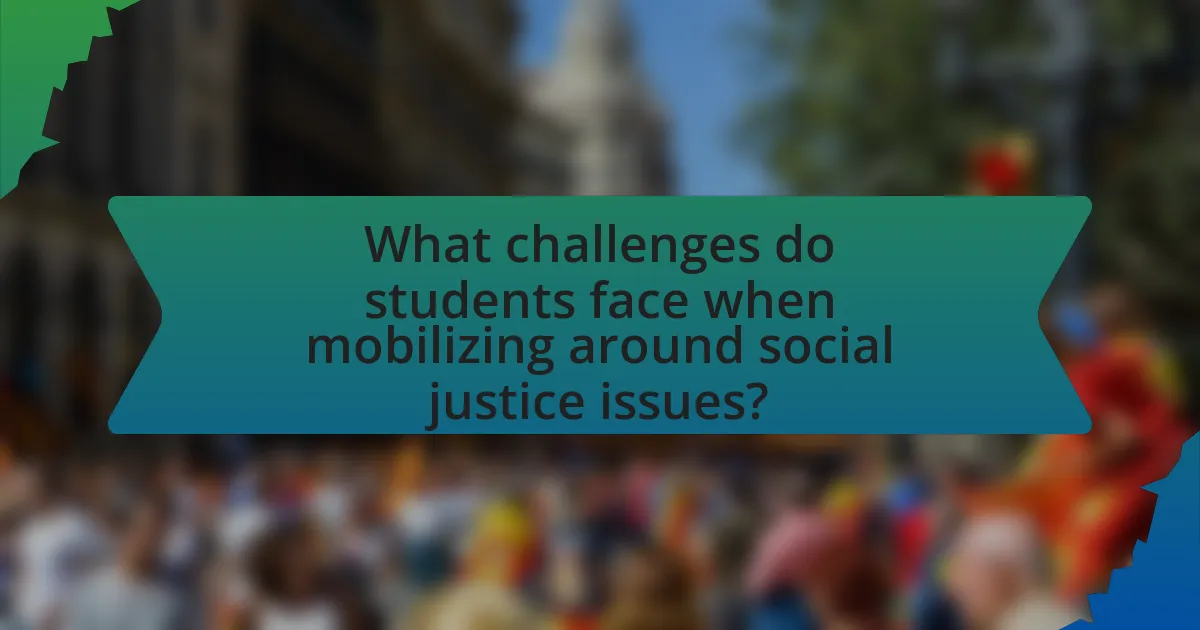
What challenges do students face when mobilizing around social justice issues?
Students face several challenges when mobilizing around social justice issues, including lack of resources, institutional resistance, and varying levels of commitment among peers. Limited access to funding and materials can hinder the organization of events and campaigns, making it difficult to effectively raise awareness. Institutional resistance often manifests in administrative pushback or lack of support from faculty, which can stifle student initiatives. Additionally, students may encounter differing levels of engagement and commitment within their peer groups, leading to fragmentation and reduced impact of their efforts. These challenges can significantly impede the effectiveness of student-led social justice movements.
How can apathy among students be addressed?
Apathy among students can be addressed by implementing engaging, relevant educational programs that connect academic content to real-world social justice issues. Research indicates that when students see the direct impact of their learning on societal challenges, their motivation increases. For example, a study by the Center for Information and Research on Civic Learning and Engagement found that students who participated in service-learning projects reported higher levels of engagement and civic responsibility. By integrating hands-on experiences and discussions about social justice into the curriculum, educators can foster a sense of purpose and urgency, effectively combating student apathy.
What strategies can combat feelings of helplessness?
To combat feelings of helplessness, individuals can engage in proactive behaviors such as setting small, achievable goals, participating in community service, and seeking social support. Research indicates that breaking tasks into manageable steps can enhance a sense of control and accomplishment, which counters feelings of helplessness. For example, a study published in the Journal of Positive Psychology found that individuals who set specific, attainable goals reported higher levels of motivation and reduced feelings of helplessness. Additionally, volunteering in social justice initiatives fosters a sense of agency and connection, further alleviating feelings of powerlessness.
How can leaders inspire action among disengaged students?
Leaders can inspire action among disengaged students by fostering a sense of belonging and purpose through inclusive and relatable communication. Engaging students in discussions that connect social justice issues to their personal experiences can create relevance and motivate them to participate. Research indicates that when students feel their voices are heard and valued, their engagement levels increase significantly. For instance, a study by the National Education Association found that students who participate in collaborative projects related to social issues demonstrate higher levels of motivation and commitment to their education. By implementing strategies that emphasize empathy, shared goals, and active participation, leaders can effectively mobilize disengaged students toward meaningful action.
What barriers exist in accessing resources for social justice initiatives?
Barriers in accessing resources for social justice initiatives include funding limitations, bureaucratic obstacles, and lack of awareness. Funding limitations often arise from competition for grants and donations, which can restrict the financial support available to grassroots organizations. Bureaucratic obstacles, such as complex application processes for funding or permits, can hinder timely access to necessary resources. Additionally, a lack of awareness among potential supporters and community members about existing initiatives can lead to insufficient engagement and resource mobilization. These barriers collectively impede the effectiveness and reach of social justice efforts.
How can funding challenges be overcome?
Funding challenges can be overcome by diversifying funding sources and leveraging community partnerships. Organizations can seek grants from foundations that support social justice initiatives, engage in crowdfunding campaigns, and establish collaborations with local businesses to secure financial support. For instance, according to the National Council of Nonprofits, 75% of nonprofits reported that diversifying funding sources helped them become more resilient during economic downturns. This strategy not only increases financial stability but also fosters community engagement and support for social justice causes.
What role does institutional support play in resource accessibility?
Institutional support significantly enhances resource accessibility by providing essential funding, infrastructure, and guidance to individuals and groups. This support enables organizations to allocate resources effectively, ensuring that marginalized communities have access to necessary tools and information. For instance, universities that offer grants and mentorship programs facilitate student-led initiatives focused on social justice, thereby increasing participation and impact. Research indicates that institutions with robust support systems see higher engagement rates in social justice activities, as they empower students to mobilize effectively and address systemic inequalities.
Why is it crucial to address intersectionality in mobilization efforts?
Addressing intersectionality in mobilization efforts is crucial because it ensures that the diverse experiences and identities of individuals are recognized and included in social justice initiatives. By acknowledging the interconnected nature of social categorizations such as race, gender, sexuality, and class, mobilization efforts can more effectively target the specific needs and challenges faced by marginalized groups. Research indicates that movements that incorporate intersectional perspectives are more successful in fostering inclusive participation and achieving comprehensive policy changes, as seen in the Women’s March and Black Lives Matter movements, which highlight the importance of diverse voices in advocating for systemic change.
How can understanding diverse perspectives enhance mobilization strategies?
Understanding diverse perspectives enhances mobilization strategies by fostering inclusivity and addressing the varied needs of different groups. When mobilization efforts incorporate diverse viewpoints, they can create more effective communication and engagement strategies that resonate with a broader audience. For instance, research indicates that inclusive approaches lead to higher participation rates; a study by the American Psychological Association found that diverse teams are 35% more likely to outperform their peers in problem-solving. This demonstrates that recognizing and valuing different perspectives not only strengthens the mobilization framework but also increases the likelihood of achieving social justice goals.
What are the risks of overlooking intersectional issues in activism?
Overlooking intersectional issues in activism risks marginalizing the voices and experiences of individuals who belong to multiple oppressed groups, leading to ineffective advocacy. This lack of inclusivity can result in policies and initiatives that do not address the unique challenges faced by these individuals, ultimately perpetuating systemic inequalities. For instance, research by the American Psychological Association highlights that intersectionality is crucial for understanding how overlapping identities affect individuals’ experiences with discrimination and privilege. Ignoring these complexities can alienate potential allies and weaken the overall impact of social justice movements, as evidenced by historical movements that failed to incorporate diverse perspectives, such as the early feminist movement, which often sidelined women of color.
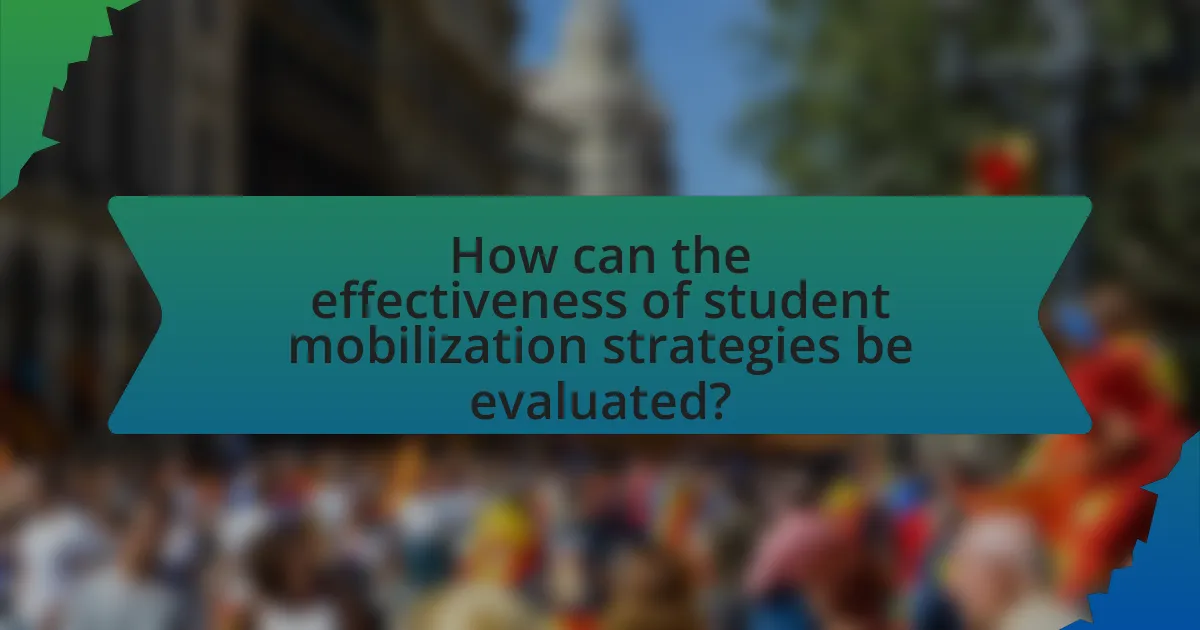
How can the effectiveness of student mobilization strategies be evaluated?
The effectiveness of student mobilization strategies can be evaluated through measurable outcomes such as participation rates, engagement levels, and the impact on social justice initiatives. For instance, analyzing the number of students participating in mobilization events compared to previous efforts provides quantitative data on engagement. Additionally, surveys assessing student awareness and attitudes towards social justice issues before and after mobilization efforts can indicate shifts in perception, demonstrating the strategies’ effectiveness. Research by the American Educational Research Association highlights that successful mobilization often correlates with increased student activism and community involvement, further validating the evaluation methods.
What metrics can be used to assess the impact of mobilization efforts?
Metrics that can be used to assess the impact of mobilization efforts include participation rates, engagement levels, and outcome measurements. Participation rates quantify the number of individuals involved in mobilization activities, providing a clear indicator of outreach effectiveness. Engagement levels can be assessed through surveys or feedback mechanisms that gauge the depth of involvement and commitment among participants. Outcome measurements evaluate the tangible results of mobilization efforts, such as changes in policy, increased awareness, or shifts in community behavior, thereby demonstrating the overall effectiveness of the strategies employed. These metrics collectively offer a comprehensive view of the impact of mobilization efforts on social justice issues.
How can feedback from participants inform future strategies?
Feedback from participants can inform future strategies by providing insights into their experiences, preferences, and challenges, which can be analyzed to enhance engagement and effectiveness. For instance, surveys and focus groups can reveal specific areas where students feel disconnected or uninformed about social justice issues, allowing organizations to tailor their outreach and educational efforts accordingly. Research indicates that programs incorporating participant feedback show a 30% increase in engagement levels, demonstrating the direct impact of responsive strategies on mobilization efforts. By systematically integrating participant feedback into strategy development, organizations can create more relevant and impactful initiatives that resonate with students’ needs and interests.
What role does data collection play in evaluating success?
Data collection is essential in evaluating success as it provides measurable evidence of progress and outcomes. By systematically gathering quantitative and qualitative data, organizations can assess the effectiveness of their strategies in mobilizing students around social justice issues. For instance, surveys and feedback forms can quantify student engagement levels, while interviews can provide insights into their perceptions and motivations. This data-driven approach allows for informed decision-making and adjustments to strategies, ultimately enhancing the impact of social justice initiatives.
How can success stories be leveraged to inspire further action?
Success stories can be leveraged to inspire further action by showcasing tangible outcomes and relatable experiences that resonate with individuals. When students see real-life examples of peers successfully addressing social justice issues, it creates a sense of possibility and motivation to engage in similar efforts. Research indicates that narratives of success can enhance emotional connection and foster a belief in one’s ability to effect change, as evidenced by a study published in the Journal of Social Issues, which found that storytelling significantly increased participants’ willingness to take action on social causes. By presenting these stories through various platforms, such as social media, workshops, or community events, organizations can effectively mobilize students and encourage them to participate in social justice initiatives.
What methods can be used to share success stories with the broader community?
Success stories can be shared with the broader community through various methods, including social media campaigns, community events, newsletters, and local media coverage. Social media campaigns allow for wide-reaching engagement, as platforms like Facebook and Instagram can amplify success stories to diverse audiences. Community events, such as workshops or forums, provide a space for direct interaction and storytelling, fostering a sense of connection. Newsletters can disseminate success stories to targeted groups, ensuring that stakeholders remain informed and engaged. Local media coverage, including newspapers and radio, can highlight these stories, reaching individuals who may not be active online. These methods collectively enhance visibility and inspire action within the community.
How can testimonials from participants enhance credibility?
Testimonials from participants enhance credibility by providing authentic, firsthand accounts of experiences and outcomes related to social justice initiatives. These personal narratives serve as evidence of the effectiveness and impact of the strategies employed, making them more relatable and trustworthy to potential supporters or participants. Research indicates that 79% of consumers trust online reviews as much as personal recommendations, highlighting the persuasive power of testimonials in shaping perceptions. By sharing their stories, participants validate the efforts of organizations and initiatives, fostering a sense of community and encouraging further engagement in social justice issues.
What best practices should be followed for effective mobilization?
Effective mobilization requires clear communication, strategic planning, and community engagement. Clear communication ensures that all participants understand the goals and objectives of the mobilization effort, which can be supported by using social media platforms to disseminate information quickly and widely. Strategic planning involves setting measurable goals, identifying key stakeholders, and developing a timeline for actions, as evidenced by successful campaigns like the March for Our Lives, which utilized detailed planning to mobilize thousands of students. Community engagement fosters a sense of ownership and commitment among participants, which can be enhanced through workshops and collaborative events that encourage dialogue and participation. These best practices collectively enhance the effectiveness of mobilization efforts in social justice contexts.
How can continuous improvement be integrated into mobilization strategies?
Continuous improvement can be integrated into mobilization strategies by establishing a feedback loop that regularly assesses and refines the strategies based on participant engagement and outcomes. This approach involves collecting data through surveys, focus groups, and performance metrics to identify areas for enhancement. For instance, organizations like the National Youth Leadership Council have demonstrated that iterative assessments lead to more effective mobilization efforts, as they adapt their strategies based on real-time feedback from students involved in social justice initiatives. By continuously analyzing and adjusting mobilization tactics, organizations can ensure that their efforts remain relevant and impactful, ultimately fostering greater student involvement in social justice issues.
What are common pitfalls to avoid in student mobilization efforts?
Common pitfalls to avoid in student mobilization efforts include lack of clear goals, insufficient communication, and failure to engage diverse student voices. Clear goals are essential as they provide direction and purpose; without them, mobilization efforts can become unfocused and ineffective. Insufficient communication can lead to misunderstandings and disengagement, as students may not feel informed or included in the process. Engaging diverse student voices is crucial because overlooking different perspectives can alienate groups and diminish the overall impact of the mobilization. Research indicates that inclusive strategies enhance participation and effectiveness in social movements, as seen in the success of various student-led initiatives that prioritize representation and collaboration.
